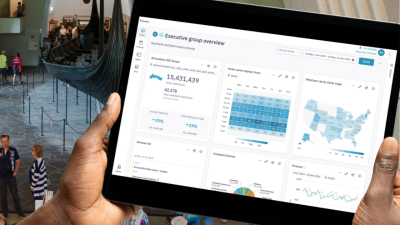
In June, reporter Robin Pogrebin published “What Does It Take to Run a Museum? The Job Description is Changing.” in The New York Times. Drawing on interviews with veteran art museum directors, a search firm executive, and an academic preparing the next generation of museum leaders, the article concludes that a successful track record in fundraising and a doctorate demonstrating subject matter expertise no longer suffice for leadership roles. (While the article examined art museums exclusively, the same points apply to museums of all types.) Instead, search committees are seeking out “increasingly complicated skill sets” to confront the issues facing our field and society, particularly the abilities to bridge communities and build consensus among staff.
Pogrebin’s article confirmed what I had learned firsthand about the museum D- and C-suite: the higher you move up in the ranks, the broader your skills need to be. Beyond the subject matter expertise (SME) most museum professionals are trained in, top leaders need acumen in areas like public administration and business. They must be able to recognize the factors that influence an organization’s fiscal health and profitability and identify new revenue streams amid the changing landscape of philanthropy.
This became increasingly clear as I moved up in my own career. Thanks to two graduate degrees earned in art history and years of teaching and curatorial experience, I felt confident overseeing the implementation of strategies that engage diverse audiences, the interdepartmental execution of complex projects, the production of new scholarship, and the cultivation and stewardship of donors. Yet, a glaring lacuna on my CV was prior undergraduate or graduate coursework in business. As I took on profit and loss responsibility and led core museum functions like collections, exhibitions, and programs in a D-level (now C-level) role, I realized that I needed to supplement my practical, on-the-job experience with formal education to grow as a leader. Deep museum experience is essential at the senior and executive levels, but to develop creative solutions to common issues in the industry, exposure to new perspectives from the for-profit sector is equally important.
Thankfully, several options for gaining this exposure exist, with programs spanning from weeks to years in length. To help others seeking to expand their skills as they advance in their careers, I’m writing this post synthesizing my research and experience seeking an opportunity that allowed me to continue in my full-time position.
Business Certificate Programs
Skip over related stories to continue reading articleMany prestigious B-schools offer certificate programs for managers and executives in online, on-site, and hybrid formats. These programs, which cover topics such as key business principles, leadership, global business practices, and more, range from weeks to months. What sets the programs apart from those well-known to museum professionals, such as the Museum Leadership Institute at Claremont Graduate University and the Center for Curatorial Leadership, is the class profile. You learn among (and from) students with a background in both the for-profit and non-profit sectors.
I completed the four-month, hybrid-format Business Management Certificate through University of Washington’s Foster School of Business in Seattle, where I live. In this program, my background in non-profits, more precisely in a museum that operates according to a mixed earned- and contributed-revenue model, complemented those of my classmates who work in key industries (e.g., aerospace, construction, e-commerce, and technology). The program was a crash course in accounting, business strategy, communication and presentation skills, finance, and leadership, with a final case competition that encouraged students to draw from prior lessons in each subject area. (My group of four, which was comprised entirely of non-profit employees, won the competition.) A thrilling test of the group’s absorption of the program content is researching and recommending a solution to a business problem.
The cost of this program—a mini-MBA, if you will—is a small fraction of an MBA or EMBA program, and there may be funding opportunities to defray the expense if your organization is unable to sponsor you. I received a partial tuition waiver, which enabled me to attend. Through the certificate program, I became more conversant in the language of business, and it encouraged me to pursue a (third) graduate degree.
MBA and EMBA Programs
MBA and Executive MBA (EMBA) programs offer intensive training in business and the corresponding credentials. Like the certificate programs described above, the benefit of both MBA and EMBA programs is peer-to-peer learning as part of a curated cohort reflecting diverse professional and personal backgrounds.
There are a few key differences between the two program types. MBA programs are designed for anyone seeking business skills, regardless of prior experience, while EMBAs are designed specifically for senior-level executives with a full-time schedule. For that reason, EMBAs are always part-time, while MBAs may be full- or part-time. This also leads to a difference in the age of students, with MBA students averaging at twenty-seven to twenty-eight years old, a decade younger than the average EMBA student, and with fewer or no years in the workforce. While the curricula of the two types are equally rigorous, they diverge in some ways because of these class profiles. MBA programs offer training in business essentials and the opportunity to tailor your course selection to your professional interests through specialization. In EMBA programs, the focus is becoming a more effective leader. There are typically fewer electives from which to choose and classmates may remain the same—you will receive a degree, as well as a professional network upon completion.
While the decision between the two may be easy for a full-time museum professional, a word of caution: EMBA programs at both private and public institutions are costly, which may be a barrier to participation for non-profit employees. According to Poets & Quants for Executives, the average cost of tuition for a ranked program is approximately $123,415 (2022), and some business schools exceed $200,000. Students from the for-profit world may be eligible to receive full or partial sponsorship from their employer. However, the EMBA can be cost-prohibitive for prospective applicants without access to tuition assistance and who may be paying off student loans for graduate degrees in other areas of study. Do not let this deter you. Scholarships are available at select schools who will value your perspective and practical experience from the non-profit sector, as it will contribute to the diversity of thought in each class. It is important to remember that this is an investment in your future professional self, and the Executive MBA Council reports a strong return on investment for graduates, including compensation increase, promotion, and/or expanded responsibilities within sixteen to twenty months following graduation. The degree will set you apart as someone with relevant museum experience and the business credentials to helm an organization.
Ultimately, I selected an eighteen-month EMBA program—Emory University’s Goizueta School of Business—that provides me with a more personalized academic experience compatible with my work schedule, as well as scholarship support. I attend class three evenings a week and my “free time” is devoted to reading case studies and preparing for class, checking in with my work group, and completing assignments. It is a significant but worthwhile time commitment, and the application of in-class learnings to my day job occurs immediately. Additional reasons I selected this program include its curricular emphasis on leadership and the diversity of the class profile—in my cohort, the students are 41 percent female, 40 percent African American, Native American, and Latine, and bring a collective one thousand years of work experience to the classroom.
Conclusion and Tips
In Pogrebin’s article, Brooklyn Museum director Anne Pasternak is quoted as saying: “You have to be an octopus, and the new generation of museum directors will have to be entrepreneurs.” The above options provide SMEs like me with a foundation in the conventions of business and shape an entrepreneurial mindset, augmenting a command of content and professional practices.
Here are some parting tips for those considering a similar path:
- Enroll in a short-term business certificate program that provides exposure to the classroom environment of business school. Shifting from the solitary, research-oriented work of graduate studies in the humanities, for example, to the teamwork of B-school may be an adjustment. However, it is essential to remember that the work of museums is collaborative, and you may have led intra- and interdepartmental projects with colleagues who brought different skills and perspectives to the table. All experience is relevant.
- Read about graduate B-schools in Poets & Quants, research MBA and EMBA programs that will contribute to your growth, attend information sessions, talk to current students in the non-profit sector, and explore scholarship funding. Select programs offer a choice of modality: on-site, hybrid, and online. Choose the one that best suits your learning needs and lifestyle.
- Determine if you can commit to hours of reading, class time (approximately six to nine hours per week), and group discussion each week. Talk about this decision with your supervisor, family, and friends.
- Pair your readings about current trends in museums with those from Harvard Business Review, The Economist, and similar publications that provide real-life examples from the for-profit sector.
Note: I have focused on business school offerings because of their accessibility to the intended audience—all museum professionals trained as subject matter experts. Founded in the 1970s, the Museum Leadership Institute (MLI) at Claremont Graduate Institute has long been recognized as the gold standard for executive education for museum leaders. The MLI program and the equivalent for mid-level managers called NextGen have been on hiatus since the start of the pandemic. The Center for Curatorial Leadership (CCL), which was started in 2007 by Elizabeth Easton and Agnes Gund, selects of small cohort of art museum curators annually for a two-week course at Columbia Business School and a mentorship with a museum director, which includes a five-day residency.









Leslie, I am glad you wrote this article to recognized how museum leadership and the profession has changed in the 21st century. In addition to education, I found various levels of previous management work experience, as well as community engagement and public service were helpful in blending the skills and making the community inroads necessary to successful museum innovation. Some communities also offer mid-career professionals short term leadership training designed to provide collaborative skill sets while introducing them to local industries, nonprofits and business leaders.
Many communities publish the urgent need for board member service in the local nonprofit sectors which provides excellent opportunities for outreach while honing leadership skills through volunteer services many nonprofits desperately welcome. This can include anything from personnel committee work to financial oversight and marketing, and in some cases lead to new museum audience development in an underserved area, a win/win. The tourism industry also provides board leadership opportunities where many communities have a tourism bureau that serves the greater community and a board that provides direction. Such opportunities often provide exposure to long term planning, market studies and branding campaigns that lead to a much broader knowledge of the community at large. Due to the circles in which these sectors operate, exposure to other community leadership follows through breakfasts, social hours and business sector seminars.
Such exposure takes the museum out of isolation and provides opportunities for stronger community ties and public awareness. Admittedly, this takes time and a supportive museum environment for entry to mid-career staff to volunteer in the community. However, it fosters lasting relationships that are invaluable in so many ways.
I am a retired museum professional who established a consulting business in retirement called Contrapposto Museum Strategies LLC. I worked with several nonprofits that included downtown business development, participated on grants panels for the state arts agency, served on and led tourism boards and joined the area Rotary clubs. I recently attended an after hours business social with my husband who is still working. I smiled to him saying I knew more people in the room than he did, and it was nice attending as a guest, having the ability to mingle with ease throughout the event without having to “ask for money”.